Customer experience (CX) is more than just a buzzword; it’s the battleground where customer loyalty is won or lost. A positive experience can turn a first-time buyer into a lifelong advocate, while a poor one can send even the most loyal customers straight to your competitors. Nowhere is this more apparent than in the contact center—the frontline of customer interactions. For many companies, this is where a customer forms their opinion of the brand, often during moments of frustration or need. How these interactions are handled can make or break the relationship.
This is where analytics prove invaluable. By harnessing the right metrics, contact centers can shift from being reactive, focused solely on problem-solving, to proactive, building loyalty with each interaction. Peter Hornberger of Brightmetrics recently highlighted how data-driven insights can help contact centers turn potential customer losses into loyalty, emphasizing that the right data enables better decisions, improves service, and ultimately elevates the overall customer experience.
The Challenge of Managing Customer Experience
The first challenge most contact centers face is identifying the key factors that influence customer experience. Traditionally, contact centers have operated reactively—addressing customer satisfaction or service issues only after problems arise. In today’s always-connected world, however, waiting for issues to occur before taking action is no longer a viable strategy. Customers now expect seamless, personalized interactions, and the stakes have never been higher.
When a contact center fails to meet these expectations, the consequences can be severe: increased churn, negative reviews, and damage to the brand’s reputation. Conversely, when a contact center performs well, it builds trust, boosts customer retention, and even turns customers into loyal advocates. The key to achieving this transformation is the ability to monitor, measure, and improve performance in real time. Analytics provide the necessary insights, enabling contact centers to understand customer behaviors, track performance, and identify areas for improvement.
Essential Metrics to Monitor
Any contact center should track several key metrics to ensure a positive customer experience. These metrics help identify areas for improvement and provide actionable insights that can lead to long-term loyalty.
1. Response Times: Customers expect prompt responses to their inquiries, whether they’re reaching out via phone, chat, or email. The speed at which an agent responds is a crucial driver of customer satisfaction. Long wait times can breed frustration and impatience, often resulting in negative reviews and increased customer churn. Conversely, fast, efficient responses build trust in your brand and show customers their time is valued.
By tracking response times, contact centers can monitor how quickly agents address customer needs. Establishing clear benchmarks and goals—such as reducing average response times—helps ensure that service levels consistently meet customer expectations.
2. Call Abandonment Rates: Call abandonment refers to the percentage of customers who hang up before reaching an agent. A high abandonment rate is often a sign of customer frustration, typically caused by long wait times or ineffective IVR (Interactive Voice Response) systems. This metric highlights customers who sought help but never received it, resulting in missed opportunities for engagement.
By closely monitoring abandonment rates, contact centers can pinpoint inefficiencies in call routing or identify where staffing adjustments are needed. Reducing abandonment rates boosts customer satisfaction and ensures that more inquiries are addressed, leading to improved outcomes for both the customer and the business.
3. Agent Performance: Individual agent performance is essential in delivering an exceptional customer experience. Are agents knowledgeable and efficient? Are they resolving issues promptly, or are customers being transferred between departments unnecessarily? Analytics offer a clear view of each agent’s performance, highlighting where additional training may be needed or where certain agents excel.
By tracking key performance indicators (KPIs) such as average handle time, customer satisfaction scores, and first contact resolution rates, contact centers can ensure consistency across their teams. This granular level of insight allows managers to deliver targeted coaching and recognize top performers, fostering a culture of continuous improvement.
4. Customer Effort Score (CES): CES gauges how easy it is for customers to resolve their issues. The simpler the resolution process, the more positive customers feel about the interaction and the company overall. A high CES, however, indicates that customers are expending too much effort, which can lead to frustration and dissatisfaction.
Tracking CES allows organizations to pinpoint where the customer journey can be streamlined. For instance, a high CES might suggest that customers are struggling with complex menus or that agents lack the tools to resolve issues efficiently. By minimizing the effort required, contact centers can enhance the customer experience and build long-term loyalty.
5. First Contact Resolution (FCR): FCR measures how often customer issues are resolved during the initial interaction without the need for follow-up calls or transfers. FCR rates are closely linked to both customer satisfaction and operational efficiency. Customers expect quick, efficient resolutions, and having to call back or be transferred between departments negatively impacts their perception of the service.
High FCR rates suggest that agents are equipped with the tools, knowledge, and authority to resolve issues on the spot, which is critical for building customer trust. By monitoring FCR rates, contact centers can identify areas where agents may require additional support or where processes can be streamlined to reduce unnecessary escalations.
Building a Metrics-Driven Culture
To fully harness the power of analytics, contact centers need to foster a metrics-driven culture. This means making data insights central to decision-making processes and ensuring all employees, from agents to managers, are trained to understand and interpret these insights.
Here are a few key strategies for building a metrics-driven culture:
1. Train teams to interpret data: It’s not enough to track metrics—employees need to understand what the data means and how it applies to their work. Providing training on data interpretation ensures that agents and managers can use the insights to make informed decisions.
2. Set clear, actionable goals: Data is most effective when it is tied to specific, actionable goals. For example, rather than simply aiming to “improve customer satisfaction,” contact centers should set measurable targets such as reducing average handle time by 10% or increasing FCR rates by 15%. Clear goals provide direction and help track progress over time.
3. Use data for continuous improvement: Metrics should be treated as a living part of the operation, not static benchmarks. Customer expectations and business needs constantly evolve, and contact centers must adapt accordingly. By regularly reviewing performance data and adjusting processes, contact centers can stay ahead of customer demands and always deliver the best possible experience.
Analytics as a Pathway to Loyalty
While tracking key metrics is essential, it’s just as important for contact centers to transition from a reactive approach to a proactive one. Reactive contact centers only address problems after they’ve surfaced—such as noticing a spike in call abandonment rates or a dip in customer satisfaction. Proactive contact centers, however, continuously monitor performance, using data to predict and prevent issues before they impact customers.
For example, predictive analytics can uncover trends like increased call volume during certain times, allowing managers to adjust staffing levels in advance. Similarly, analyzing past performance data helps identify agents who might need additional training or processes that should be streamlined to enhance customer satisfaction. This proactive mindset enables contact centers to not only react to current challenges but also foresee and mitigate future ones.
Ultimately, contact centers have the power to transform every customer interaction into an opportunity to foster loyalty. By leveraging the right analytics and cultivating a data-driven culture, they can shift from a reactive to a proactive approach—resolving issues before they escalate and continuously refining the customer experience. With these metrics and practices in place, contact centers can turn potential customer losses into long-lasting relationships, driving not only retention but also brand advocacy and sustainable business success.




